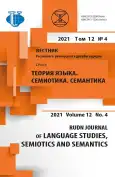Semiotics of Advertising Communication in WEB 2.0 Network Social Services
- Autores: Zotova A.S.1
-
Afiliações:
- Moscow State University of Technology and Management named after K.G. Razumovsky
- Edição: Volume 12, Nº 4 (2021)
- Páginas: 1285-1298
- Seção: SEMIOTIC STUDIES
- URL: https://journal-vniispk.ru/2313-2299/article/view/323347
- DOI: https://doi.org/10.22363/2313-2299-2021-12-4-1285-1298
- ID: 323347
Citar
Texto integral
Resumo
The article is devoted to the study of semiotics in the advertising communication of web 2.0 network social services. The purpose of the article is to analyze the publications of various brands on social Internet services focused on communication with the consumer and the subsequent study of the features of the use of semiotics tools. The relevance of the article is due to the fact that the modern information society has increased interest in semiotic systems, including in the field of Internet communication. The modern vision of semiotics has gone beyond the traditional framework and defined it as part of global and local communication in web 2.0 social network services, not only between Internet users, but also in the areas of B2B and B2C. The study of the possibilities of semiotics in advertising communication on web 2.0 social platforms, using the example of search engine applications, the social network Instagram, and company sites, in this article is based on the works of R. Barthes, J. Baudrillard, Y. Lotman, and U. Eco. This material confirms our hypothesis that today, especially since the beginning of the pandemic, communication on web 2.0 services is not limited only to text with a picture/photos or videos, more and more often there are visualized scenes created with the help of graphic design with the use of symbols and iconic signs that are familiar to the consumer, which he easily decodes, since they are inscribed in his socio-cultural coordinate system. The innovation of the research is based on the fixation of modern criteria of advertising Internet communication: polycode, intertextuality and multimedia, used as a way of working with target audiences. The novelty of the material consists of the understanding that semiotics today is a new look not only at the branch of scientific knowledge, but also at the practical possibilities of sign systems in the digital age, when the sign becomes a part of the socio-cultural space, a trend of the global world, a tool for transmitting information, knowledge, positioning, a tool for manipulation, influence, and attracting attention. Thus, brands working with the audience in today’s realities should take into account not only the product preferences of consumers, but also broadcast their social / civic activity.
Palavras-chave
Sobre autores
Anna Zotova
Moscow State University of Technology and Management named after K.G. Razumovsky
Autor responsável pela correspondência
Email: annazot@bk.ru
ORCID ID: 0000-0002-0025-5332
Associate-Professor of the Department of Public Processes, Mass Media and Advertising Technologies
Zemlyanoj Val, 73, Moscow, Russian Federation, 109004Bibliografia
- Morris, Ch.U. (1983). The foundations of the theory of signs. In: Semiotics. Moscow. (In Russ.).
- Lotman, Yu.M. (2000). Inside the thinking worlds. In: Semiosphere. Saint-Petersburg. (In Russ.).
- Barthes, R. (2008). Fundamentals of Semiology. In: Zero degree of writing. Moscow: Akadem, project. (In Russ.).
- Kokoreva, E.A. (2014). Semiology of R. Barth: writing, ideology, mythology. Vestnik permskogo universiteta. Seriya filosofia psikhologiya sotsiologiya, 2(18), 94—99. (In Russ.).
- Baudrillard, J. (2006). Consumer Society. Its myths and structures. Moscow: Republic; Cultural Revolution. (In Russ.).
- Arutyunyan, S.M. (2008). The main stages of semiotics formation. The Bulletin of Moscow State University of Culture and Arts. Moscow, 2, 33—37. (In Russ.).
- Eco, U. (2016). Trattato di semiotica generale. Milano: La nave di Teseo. (In Ital.).
- Eco, U. (1984). Semiotica e filosofia del linguaggio. Torino: Einaudi. (In Ital.).
- Lutero, T. (2015). About the concept of U. Eco and its contribution to semiological research. Language and culture, 18, 129—133. (In Russ.).
- Zotova, A.S. (2013). Communicative Strategies in Contemporary Media Discourse and Word-Formative Devices for Their Implementation. Modern problems of science and education, 6, 752. (In Russ.).
- Pashkevich, T.V. (2015). Semiotics Ideas of Humberto Eco in Training of Bachelors on Advertising and Public Relations. Polzunovskij al’manah, 3, 165—169. (In Russ.).
- Pocheptsov, G.G. (2002). Semiotics. Moscow: Refl-buk, K.: Wakler. (In Russ.).
Arquivos suplementares









